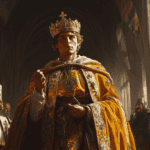
Henry IV, Holy Roman Emperor, was a pivotal figure in 11th-century European history, known for his tumultuous reign and infamous conflict with the papacy. Born on November 11, 1050, Henry ascended to the throne at the tender age of six, following the death of his father, Henry III, in 1056.
Early Years and Regency
During Henry’s minority, his mother Agnes of Poitou acted as regent. Her rule was marked by attempts to secure support from German aristocrats through land grants, a strategy that weakened royal authority. In 1062, Archbishop Anno II of Cologne orchestrated Henry’s kidnapping, effectively taking control of the regency until Henry came of age in 1065.
Upon reaching majority, Henry IV assumed full control of his realm. He was crowned King of Germany in 1054 and later became King of Italy and Burgundy in 1056. His early reign was characterized by efforts to consolidate power and manage the complex political landscape of the Holy Roman Empire.
Trial by Combat

Henry’s reign was significantly impacted by internal conflicts within the empire; he faced frequent rebellions from powerful German nobles. In 1070, a significant conflict arose between King Henry and Otto of Nordheim, Duke of Bavaria. This dispute marked a turning point in their relationship and had far-reaching consequences for both men.
The accusation against Otto came from a man named Egeno, described as “a thug of ill repute”. Egeno publicly claimed that Otto had attempted to hire him to assassinate King Henry IV. This serious allegation threatened Otto’s position and reputation.
Otto vehemently denied the accusation. In accordance with 11th-century custom, when it was one man’s word against another’s, the matter was to be resolved through trial by combat. This method of settling disputes was common in Germanic law when there were no witnesses or confessions.
The trial by combat was scheduled to take place in Goslar. However, events took an unexpected turn when Otto initially accepted the ruling but then failed to appear on the set dates for the combat. This failure to show up had serious consequences for Otto.
As a result of Otto’s non-appearance, Henry IV was able to demand a judgment in default. The Saxon nobles, who were assembled as the jury, granted this request. The consequences for Otto were severe: he was stripped of his duchy of Bavaria, all other fiefs, and even his allodial possessions. Furthermore, Otto was declared an outlaw. Otto remained in arms against the king until his death on January 11, 1083.
The Saxon Rebellion
In 1073, Holy Roman Emperor Henry IV faced a significant challenge to his rule in the form of the Saxon Rebellion. This revolt was sparked by Henry’s attempts to consolidate power and recover royal estates lost during his minority. His policies, which included appointing low-ranking officials to carry out his new initiatives, caused discontent among the nobility in Saxony and Thuringia.
The rebellion began in the summer of 1073 when Saxon princes arrived at the Imperial Palace of Goslar to voice their grievances. Henry refused to negotiate, leading to a large Saxon army advancing on his position. The emperor fled to Harzburg Castle, where he was besieged by the rebels led by Count Otto of Nordheim and Bishop Burchard II of Halberstadt.
Henry managed to escape and retreated to southern Germany, but found little support among the imperial princes. In January 1074, he faced the much larger Saxon army at Hersfeld with only a small force. Both sides were reluctant to engage in battle, leading to peace negotiations at Gerstungen on February 2, 1074.
The peace agreement included Henry’s consent to demolish his castles on the edge of the Harz mountains. However, when peasants destroyed the Harzburg castle and desecrated royal tombs in March 1074, it caused outrage across the kingdom and brought many imperial princes back to Henry’s side.
The conflict culminated in a decisive battle on June 9, 1075, near Homburg on the Unstrut river. Henry’s forces, which included allies such as Duke Rudolf of Rheinfelden and Duke Vratislaus II of Bohemia, ultimately defeated the Saxon rebels. This victory resulted in the surrender of the Saxon leaders and the imprisonment of many Saxon princes, effectively ending the rebellion and strengthening Henry’s position.
The Investiture Controversy
The defining conflict of Henry’s reign was the Investiture Controversy, a power struggle between the monarchy and the papacy over the appointment of church officials. This dispute came to a head during the papacy of Gregory VII, who sought to reform the church and assert papal authority over secular rulers.
In 1075, Gregory VII issued a decree prohibiting lay investiture, the practice of monarchs appointing church officials. Henry, viewing this as an infringement on his royal prerogatives, continued to appoint German bishops at will. The situation escalated when Henry declared Gregory deposed, leading to his excommunication by the pope in 1076.
The Walk to Canossa

The excommunication threatened Henry’s political position, as it released his subjects from their oaths of allegiance. Facing potential rebellion, Henry was compelled to seek reconciliation with the pope. This led to the famous “Walk to Canossa” in January 1077.
Henry journeyed to Canossa Castle in northern Italy, where Pope Gregory VII was staying as a guest of Countess Matilda of Tuscany. For three days, from January 25 to 27, Henry stood outside the castle gates, dressed as a penitent and pleading for forgiveness.
This act of penance, known as the “Humiliation of Canossa,” was a calculated political move. By forcing the pope to grant him absolution, Henry sought to undermine his opponents in Germany who were using the excommunication as a pretext for rebellion.
Gregory VII eventually relented, lifting the excommunication and receiving Henry back into the Church. However, this reconciliation was short-lived, as Henry soon violated the conditions imposed by the pope.
Aftermath and Continued Conflict

The years following Canossa were marked by ongoing strife. The conflict between Holy Roman Emperor Henry IV and Rudolf of Swabia was a pivotal moment in the history of the Holy Roman Empire. Rudolf, who had been a supporter of Henry IV, turned against him during the Investiture Controversy. In March 1077, Rudolf was elected anti-king by a group of princes who opposed Henry’s rule.
This election led to a protracted civil war within the empire. Henry IV retaliated by confiscating Rudolf’s duchy of Swabia and invading his territories. The conflict lasted for several years, with both sides engaging in battles and political maneuvering. In 1080, Gregory VII excommunicated Henry for a second time, placing his support behind Rudolf.
The climax of this struggle came on October 14, 1080, at the Battle of Elster, near Leipzig. Henry’s forces were outnumbered and initially retreated to the Elster River. The battle was fierce, with Rudolf’s troops, led by Otto of Nordheim, breaking through Henry’s defenses and causing significant damage.
Although Henry’s army suffered a military defeat and many of his warriors drowned while trying to escape across the Elster River, the battle ended with a strategic victory for Henry. During the fighting, Rudolf was fatally wounded when one of Henry’s knights cut off his right hand and stabbed him in the abdomen.
Rudolf died the next day at Merseburg, and his death dealt a severe blow to the rebellion against Henry. The loss of Rudolf’s “Schwurhand” (swearing hand) was seen as a divine judgment, further weakening support for the princes’ revolt.
With Rudolf’s death, the rebellion lost its focus, and Henry was able to consolidate his power. This battle marked a turning point in the civil war, ultimately leading to Henry’s triumph over his internal enemies and strengthening his position as Holy Roman Emperor.
The Italian Campaigns
From 1081 onwards, Henry IV launched a series of military campaigns in Italy. These campaigns were primarily aimed at asserting his authority over the papacy and securing his position as Holy Roman Emperor. In 1084, after besieging Rome, Henry entered the city, deposed Pope Gregory VII, and had himself crowned Holy Roman Emperor by the antipope Clement III.
Following his coronation, Henry turned his attention to one of his main Italian opponents, Matilda of Tuscany. He declared her deposed for lese majesty and confiscated her possessions. In 1089, Henry launched a full-scale invasion against Matilda’s territories
Later Years and Abdication
The latter part of Henry’s reign was plagued by continued conflicts. He was excommunicated once more by Pope Victor III and spent four years cut off from Germany. In 1105, under pressure from his son (the future Henry V) and other nobles, Henry IV was forced to abdicate the throne; he died on August 7, 1106, shortly after his abdication.




